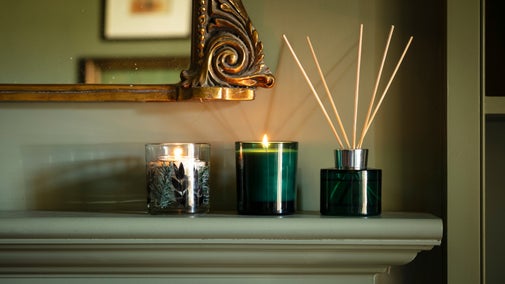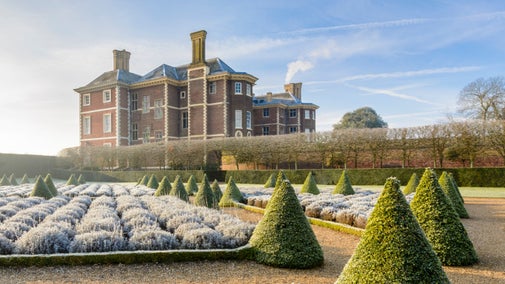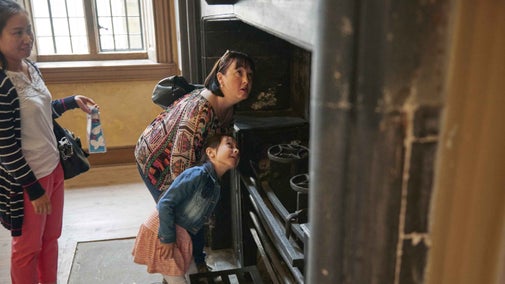Things to see and do at Chedworth Roman Villa

Jump to
Discover the remains of one of the grandest Roman villas in Britain. Walk along the suspended walkways to see some of the most impressive in-situ Roman mosaics in the country, as well as hypocaust systems and bath-houses. Step inside the museum to discover a range of finds and artefacts from the villa, find out more about Britain’s Roman past, and soak up the views of the surrounding Cotswold countryside.
See the mosaics
Chedworth Roman Villa has some of the most impressive in-situ Roman mosaics in Britain, as well as bath-house rooms and hypocaust systems.
You can walk along the suspended walkways in the modern conservation building and look down on these pieces of art which offer an insight into Britain’s Roman past.
Visit the museum
The museum houses fascinating artefacts which have been unearthed during on-site excavations at Chedworth Roma Villa. They give an insight into the different religions which would have been worshipped here and you can see Roman jewellery, figurines, coins and more.

Stop by the Nymphaeum water shrine
Offerings to the water goddess were made at the Nymphaeum which is still fed by the ancient water that filters through the Cotswold limestone.
It is also an area bursting with wildlife as a variety of animals that call Chedworth Roman Villa home often visit this feature. Look out of frogs, newts and Roman snails.
Take in the Cotswold views
There are picnic benches and seating where you can unwind in this tranquil setting and soak up the views of the surrounding Cotswold countryside.
Spot seasonal wildlife
Chedworth Roman Villa is home to a variety of plants and wildlife, some rare and some making use of the ancient remains.
Birds
Throughout the seasons many different birds can be regularly spotted around the villa including some less common songbirds like nuthatch and grey wagtail. With the arrival of spring and summer, the villa sees the return of the swifts and house martins who take up residence around the roof of the lodge to hatch their chicks.
Deer and hares
Several varieties of deer can be found in the area surrounding the villa, with sightings most common early in the day when the combe is quiet. It's not unusual to encounter a hare suddenly jumping up from behind one of the historic stone walls.
Bats
A number of bat species are at home here and nest in the loft space of the Visitor Centre. They can most often be seen in the early evening when they emerge to hunt for insects.

Roman snails
It's not just birds and mammals who call the villa home. There's also a wide variety of reptiles and invertebrates, some of which are very rare including the Roman snail (Helix Pomatia). These large, pale snails were brought to the villa as a popular delicacy of Romano-British cuisine over 1,800 years ago and are still here today.
The snails prefer the cooler areas of the villa site during the warmer months and hibernate during the winter. Uniquely for a species which originated elsewhere, Roman snails are protected and can only be handled by those with a special licence.
Butterflies
Throughout the spring and warm summer months, many different varieties of butterfly can be seen feeding on flowers across the North Range and flowerbeds, including some rare species. Dragonflies are also very visible during the summer, flying across the site.
Newts and reptiles
Great crested and palmate newts have both been spotted here by wildlife experts. The males of these great crested newts can be recognised by a distinctly large dragon-like crest and a flame-shaped tail. Head to the Roman water shrine (nymphaeum) for one of the best spots to see them.
During the winter, newts will hibernate and appear again in the spring. Frogs can also be found at the nymphaeum and frogspawn is a common sight during spring.
Insects such as waterboatmen live on the water and can regularly be seen on the surface of the water. Around the walls of the North Range common lizards have also been seen, basking on the stones.
You might also be interested in
The mosaic floor at Chedworth Roman Villa
Chedworth Roman Villa has some of the most impressive in-situ Roman mosaics in the country and a close up look gives an insight into life in Roman Britain.

Eating and shopping at Chedworth Roman Villa
Tuck into a seasonal menu of tasty meals in the café at Chedworth Roman Villa, near Cheltenham, or visit the shop to discover gorgeous homewares, gifts and more.

History of Chedworth Roman Villa
Discover 2,000 years of history at Chedworth Roman Villa. Find out about its construction, heyday and decline, and unearth the stories of a wealthy owner and a Victorian discovery.

Archaeological discoveries at Chedworth Roman Villa
Discover the unusual objects that have been unearthed at Chedworth; from a 5th-century mosaic to bone hair pins and pottery.

Houses and buildings
Historic houses and buildings are full of stories, art and collections. Learn more about their past and plan your next visit.

Houses and buildings to visit in Gloucestershire and the Cotswolds
Explore houses and buildings in Gloucestershire & the Cotswolds from a house crammed with collections right up to the attics and a Victorian lodge on the site of a Roman villa. Step inside to find discoveries that will amaze the whole family including a model village and colourful Roman mosaic floor.
